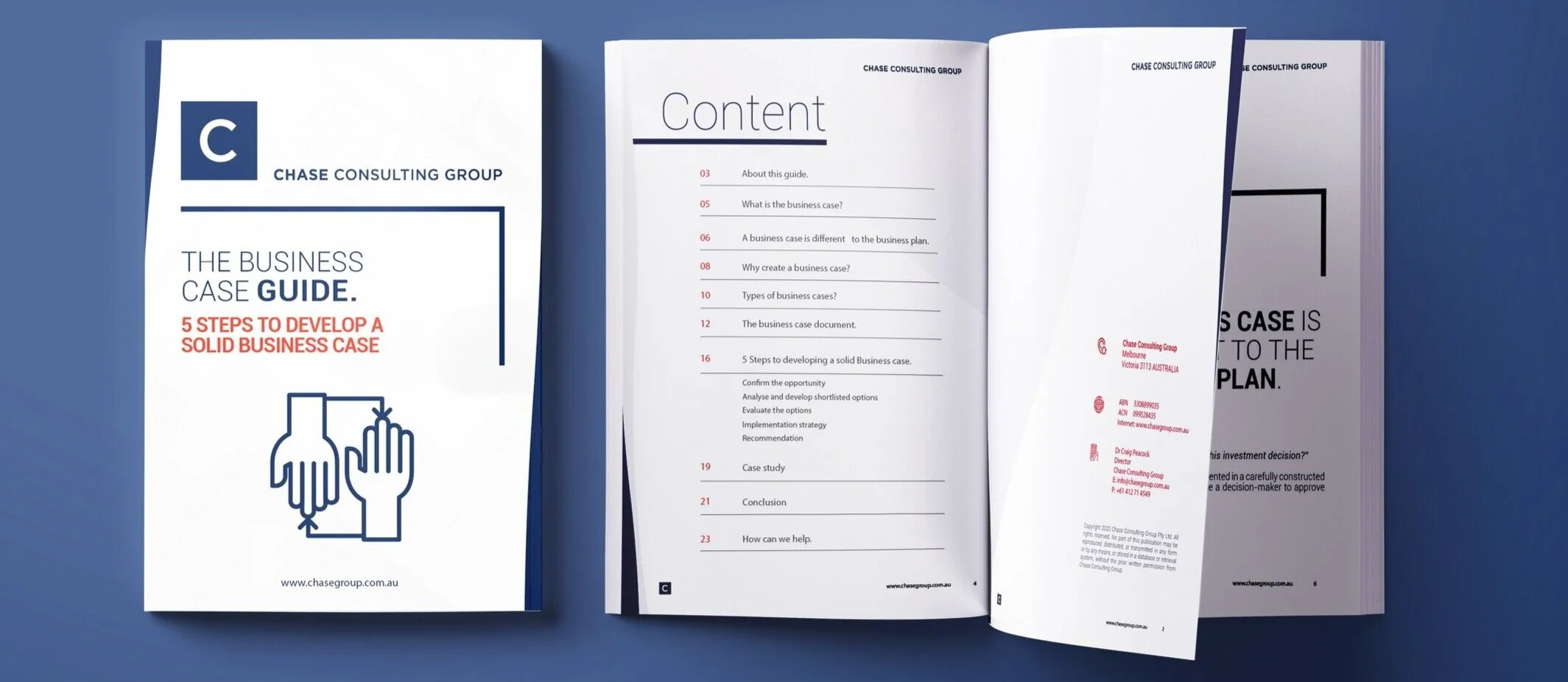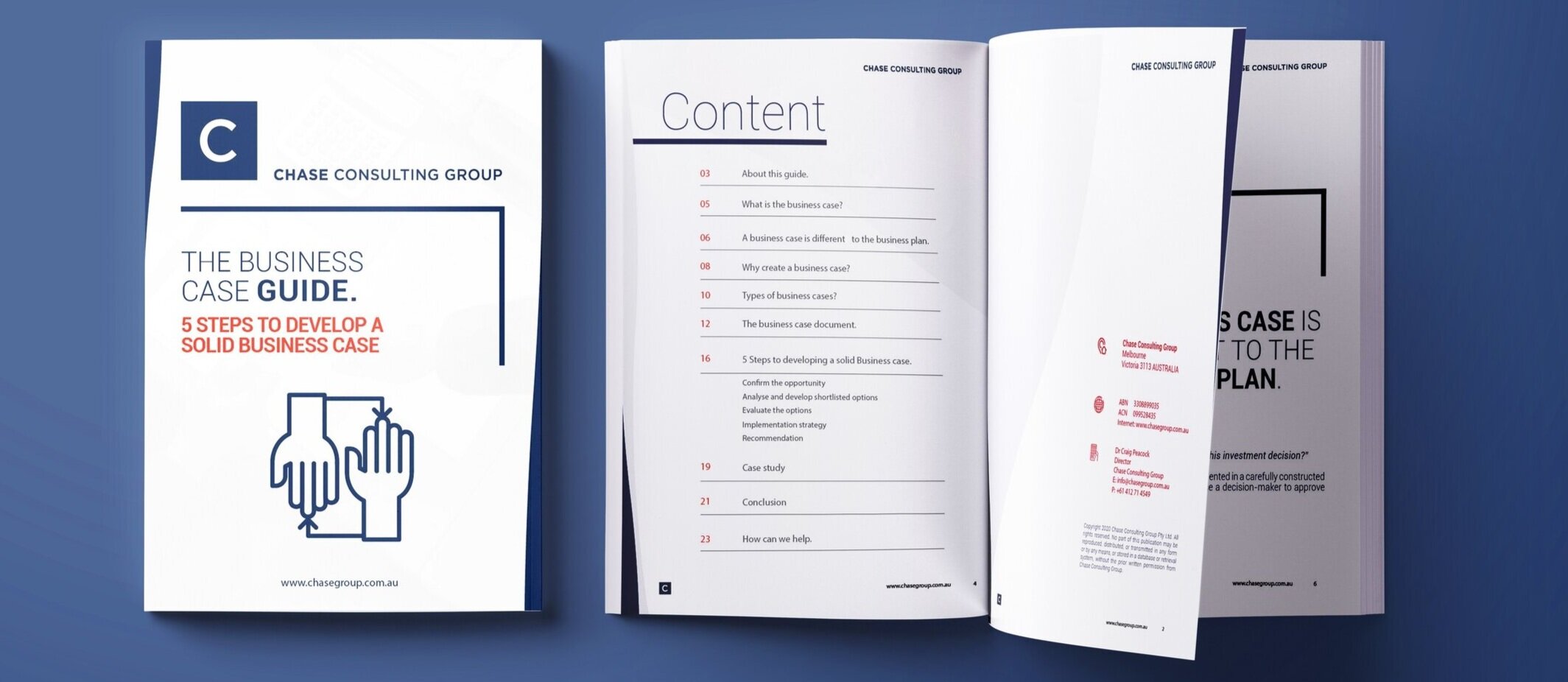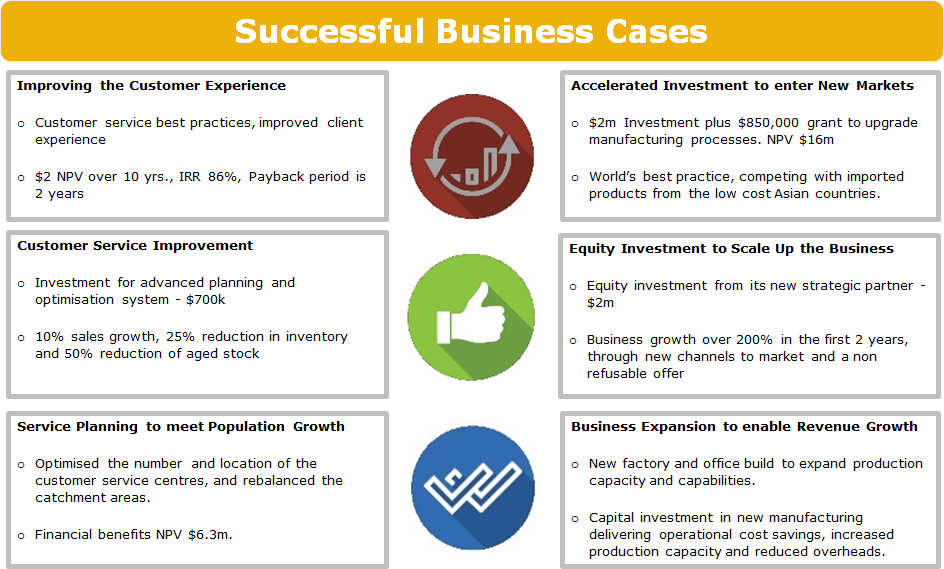How to Build a Business Case 4 Easy Steps
5 Steps to Develop a Solid Business Case
What is a business case?
As organizations and companies become more focused on delivering real business value, it becomes increasingly important for the board of directors and senior executives to focus their attention on investments that deliver true value. Initiatives throughout the organization, including new products and services, innovations, CAPEX proposals, IT projects, investment opportunities, new business ventures, and factory relocations, are either accepted or rejected based on their business value.
To get the board, the executive team or external stakeholders and investors to approve a project, it is necessary to build a robust and compelling business case that demonstrates why the project is needed and what the benefits of the project will be when it is finalized. The reasons and benefits of a project may seem perfectly obvious to you and others intimately involved with it; however, they may not be so apparent to stakeholders and other decision-makers. Often, they deal with a myriad of different business units and objectives and tasks that need to be done. Therefore, a well-prepared business case can help your project stand out amongst the competing priorities within the organization and may be the key to getting approval and finances for the project.
The business case is a process of critically examining the opportunities, alternatives, project stages, and financial investment to recommend the best course of action that will create business value.
Business cases help organizations make better investment decisions.

A business case is different to the business plan
Think of your business case as a sales pitch with robust analysis and justification. The business case is one of the most powerful decision-making tools available to the organization's leadership team. It is a decision-making tool that provides the leadership team with an assessment of a particular decision's investment, benefits and risks.
A business case answers the question: what will happen if we proceed with this investment decision? The justification for the business case is presented in a carefully constructed document detailing the rationale to convince a decision-maker to approve the investment recommendation.
The business case process helps organizations formulate innovations, projects and changes. The business case document is a crucial building block of project success with senior-level involvement. It explains the project's business value to enable the stakeholders to make decisions.
The fundamental questions to consider in developing the business case are:
-
Which of the alternatives should we invest in to generate the most value for the organization?
-
Are other alternatives more profitable?
-
Will this investment deliver benefits of high value?
-
-
Is it strategically the best approach?
-
Should the organization consider investing at all in this proposal?
The practical question must also be addressed: can the business proposal be implemented as planned, delivered on time and budget and produce the expected benefits?
The making of a business case will carefully examine the benefits and risks involved in proceeding with the recommendation, the alternatives and the benefits of the recommendation, and the risks of not proceeding. A strong business case will make a compelling recommendation for implementation.
In comparison, a business plan is a documented set of business goals, objectives and strategies that an organization aims to achieve over the next three to five years. The business plan includes market information, customer segmentation, products and services, sales forecasts and cost estimates, and financial forecasts.

Why create the business case?
Preparing the business case enables you to take a disciplined approach to critically examine the opportunity, the alternatives, the project stages and the financial investment to make a recommendation for the best course of action to create the business value.
When the time is taken to develop a solid business case, the investment proposal is much more informed. In turn, this will increase the project's benefits and value and reduce the risks. As a result, there is a much greater likelihood of securing support to proceed with the investment.
A business case is required when you need to:
-
Demonstrate the value a proposed product or service would generate for your organization;
-
Obtain board approval for investment;
-
Decide whether to outsource a particular function;
-
Relocate business operations and manufacturing facilities;
-
Prioritize projects within your organization that are competing for funding and resources;
-
Secure the financial funding and resources to implement the project.
By well-documenting the business case, you can proficiently present the recommendation to stakeholders whose support is required for approval. In addition, the documented business case will provide confidence and a level of certainty that the considered proposal will be successful.
Types of business cases
The required depth of analysis that is documented in support of your case will be based on the size and complexity of the investment decision. For example, the business case for an investment of $5m or less is much simpler than the business case for an investment of $500m or more.
The business case sets out a justification for the investment that a potential investment would require. A preliminary business is often prepared for large investments and high-risk projects as the first step in preparing the full business case. Then, it is used to decide whether the potential project merits being investigated in more detail. For example, the preliminary business case may include cost estimates with a 20% tolerance, whereas the full business case would include costings with less than a 10% tolerance.
The business case should be prepared early in the project before any decision has been made to initiate. It allows the organization to explore high-level options for meeting business requirements. This may include an assessment of comparable projects.
Experienced organizations may have in-house expertise allowing them to prepare a business case. However, some organizations will not have the full range of skills required and may wish to appoint an independent management consultant to assist them.
5 Steps to Developing a Solid Business Case
The process of developing the business case is important; a well-executed strategy enables you to create a solid business case that increases the benefits and value and reduces the risks. This also increases the likelihood of securing support to proceed with the investment.
Here is our five STEPS business case development framework. It's a simple, easy-to-follow and effective way of developing your business cases for the board, the executive team, the business owners, external stakeholders and investors.

The five critical steps for creating the business case are:
Step 1: Confirm the Opportunity
Describe the situation and the business opportunity that your proposal will impact. This will include the background to the project, the investment logic and the high-level business requirements.
We develop the strategic logic for the business case. Then, we define how the project supports the organization's strategic objectives. It's much easier to justify the business case if you can show how it helps achieve one or more strategic objectives. Then, we get sign-off from our business case project sponsor.
Step 2: Analyze and Select the Short-listed Options
Identify the alternative approaches and select three or four options to analyze. Gather information about each alternative, analyze the options and develop the shortlisted options.
We develop a long list of alternative solutions before selecting our short lists of options.
The longlist should include a wide range of reasonable options and a detailed evidence-based assessment to determine a shorter list of these options.
Step 3: Evaluate the Options
Evaluate how the options will deliver the business objectives, quantify the benefits of each potential solution, and then select the preferred option, taking into account the strategic, financial and societal value created and the risks.
Quantifying the business benefits is central to strategic planning, financial, cost-benefit, and business case analysis. So first, we develop the financial projections. This includes the detailed revenue and operational cost model and financial model. Next, we develop the cash flow statement for our discounted cash flow projections (or DCF) analysis. Finally, we confirm the hurdle rates are the minimum acceptable internal rates of return for investments. It's an essential metric for investors, private equity firms and management teams to evaluate potential opportunities.
Step 4: Develop the Implementation Strategy
Create the implementation plan for the preferred option, detailing how to achieve the business objectives, the resources needed, the project team, who will be accountable for each milestone, and how to mitigate the project risks.
In these steps, you confirm the total project cost. In addition to estimating the total project cost, we break down the project costs for each project milestone. This will help you understand the CAPEX costs and the ongoing costs.
Step 5: Develop the Recommendations and Get the Approval from Decision-Makers
The objective is the get the approval from the board, executive team, external stakeholders or investors for the business case.
Confirm the recommended option. Create the business case documents and present the business case recommendation to the board, executive team or investors for approval to proceed.
It's writing the business case, a pervasive document recommending your organization's best course of action.
How you frame the business case recommendations is essential. The proper business case structure helps the decision-makers understand what needs to be done and why. It also provides information about how much time and money will be required to complete the project.
It answers the questions the board, executive team, external stakeholders, and investors will ask. What are the risks? What are the upsides? What is the cost of doing nothing? What is the financial impact of this investment?
How to write a good business case?
You must complete all these steps to create a solid business case.
Our five steps business case development framework helps you write a business case that can help you get the resources you need to get the approvals and manage and implement a successful project.

What to Include in the Business Case Document?
A compelling business case outlines the expected benefits of this investment decision.
The business case document should explain the following:
-
The investment decision;
-
Key objectives for the project;
-
The business need;
-
The project definition. Provide necessary background and supporting information to put the investment into context;
-
Describe how the investment aligns with the organization's strategic business plan;
-
Describe the different options explored and why you are recommending this option or solution;
-
Provide a robust budget, an estimate of the whole-of-life costs of the investment and its financial benefits and the projected financial statements;
-
The business benefits include an estimate of the non-financial benefits;
-
How to make sustainability core to the recommendation and outcomes.
-
Describe the approach to be used, including timelines, resources, the procurement strategy, project governance, and how to embed sustainability practices;
-
Rigorously assess the inherent risks, different scenarios and sensitivities, including how they are likely to affect the investment and outline strategies for mitigating them;
-
Convey the level of uncertainty surrounding the proposal;
-
Provide options for the board and management to consider in reaching a decision.
In large organizations, there are often guidelines defined for the business case writer to help them write what's called an "investment appraisal" for their business case.
Who Prepares the Business Case?
Any leadership or professional role may assume responsibility for producing and writing the business case if the decision-makers trust that individual. Thus, executives, business leaders, project managers, business analysts, internal and external consultants, and IT managers are included.
The project sponsor or project manager may lead the development of the business case.
The goals of the recommended project, the project customers, users and stakeholders, and the business outcomes and benefits are more important than technology, domain knowledge, or deliverables in a robust business case.
The business case writer focuses on evaluating, analyzing, quantifying and delivering the business value. Poor project results can result from insufficient attention to the details of a business case and accompanying analysis.

Advantages of a Business Case
The business case document or presentation communicates the high-level information relevant to a critical decision.
The business case discusses the required funding for a potential investment project. Then, it is your sales pitch!
Developing business cases offers real advantages:
-
The business case helps to identify and evaluate alternatives and to compare their relative costs and benefits. A business case is a tool for strategic planning and decision-making.
-
The purpose of the business case is to outline the organization's plan for the project - risk, return, the investment required, time and financial break-even and other elements.
-
Aligning stakeholders' expectations to the project's approach, outcomes and benefits of an initiative.
-
It increases the likelihood of a project's success.
-
The business case can be turned into a project plan. It highlights the project's milestones and how to apply the project resources.
-
It is easier to see success.
-
The strategy section puts the business case into context, explaining why the organization is looking to invest.
-
The justification gives a detailed breakdown of the costs, revenue, and net impact of the investment, presenting the case for the investment.
-
It explains the risks and opportunities associated with the recommendation.
-
Projects fail without having a solid business case to support them. The business case document is necessary to start a project and is the basis for the project charter and the project plan.
Six Business Case Examples
These six business case examples highlight the essential information required in developing business cases for recovery and growth.
1. New Product Business Case Example
This business case example justifies the investment to introduce a product or service into a highly competitive market.
The business case should address:
-
Strategic positioning of the new product/service/innovation in the market.
-
Market demand and pricing.
-
Initial order quantities for products.
-
Service delivery model.
-
Customer service and supporting clients and channel partners.
2. Investment (Equity or Finance) to Scale Up the Business
This business case example seeks to raise an equity investment or finance a business or joint venture.
The business case addresses:
• The opportunity and return on investment for the investor or financier.
• How the business or joint venture will scale up and achieve the projected growth.
• Details where the funding will be applied in the business, such as capital, working capital, operating expenses, etc.
• Explains the return on investment (ROI) from the investment.
3. How to build a business case for a CAPEX project
To win the approval of a CAPEX project, you need to demonstrate that its benefits outweigh its costs.
The business case for a CAPEX project will include details about how the project will save the company money.
These details may consist of benefits like reduced operating costs, increased efficiency, improved revenues, and new or improved capabilities.
A high-risk CAPEX project offers the potential for a high return on investment but comes with a high level of uncertainty. Therefore, it is not a viable investment without a detailed business case that clearly shows how it will benefit the company.
The business case summarizes all the factors that make a CAPEX project worth investing in. It summarizes the financial, strategic, operational, and organizational factors influencing the decision.
4. Customer Experience Business Case Example
This business case example recommends a project or initiative to improve client experience.
The business case makes the recommendation for the decision-makers to approve the project, funding and resources. It explains:
-
How the client experience will be improved
-
The critical metrics:
Net promoter score (NPS)
Customer satisfaction (CSAT)
Customer Churn
Annual recurring revenue
Sales conversion rate
Customer long-term value
-
Quantities the strategic, financial and client outcomes.
-
Determines the return on investment (ROI).
-
Recommends the implementation approach.
5.Government Grant Business Case
This business case example justifies the investment to expand and diversify the business and secure government grants.
The business case addresses:
-
The expansion strategy and the proposed investment.
-
The market demand, export growth and import replacement.
-
The roadmap to expand the business.
-
The jobs growth from the investment.
-
The outcomes for the industry or sector.
-
How the grant will bring forward the investment.
-
Why the government grant is needed.
-
How the business will fund its contribution.
6. Marketing Innovations, Products or Services
This business case example supports the marketing strategy for innovations, new products or services.
The business case demonstrates to prospective buyers how to justify the purchase. In addition, it explains the return on investment (ROI) from purchasing the new technology, product or service.
It explains :
-
How the business case based is aligned to business priorities and strategies.
-
The strategic logic - the revenue model hypotheses.
-
The impact on brand and customer metrics.
-
The different revenue growth scenarios.
Infrastructure Business Case Example
Infrastructure business cases are economic business case to justify infrastructure projects or significant industry or sector projects.
Major infrastructure projects take many years to build and cost multiple billions. They also employ thousands of workers at their peak. Several business cases are developed along the investment journey until the final business case is approved. Multiple options are explored and analyzed to create the best possible business case. Then the shortlist options are evaluated in detail to recommend the best option. These types of business cases also address environmental impacts.
Three types of business cases are developed in high-risk, high-value projects:
-
Strategic or Initial business
-
Preliminary business case
-
Full business case.
The preliminary business case or feasibility study can be more than 1,000 pages, including appendices costing several million dollars. The full business case can cost many millions and take at least 12 months to develop and include significant community consultations.
Here is the Infrastructure Business Case for the Melbourne Metro rail tunnel project.
Successful Business Case Examples
Chase Consulting has been developing business cases for over twenty years. A common characteristic of our successful business cases is that we followed the 5 STEPS framework for developing business cases and used a comprehensive set of business case templates. This approach ensured that we created high-quality business cases, saving us time and increasing productivity.
Here are six successful business case examples:
-
Improving the customer experience
-
Accelerated investment to enter new markets
-
Equity investment to scale up the business
-
Customer service improvement
-
Service planning to meet population growth
-
Business expansion to enable revenue growth

These six business case examples were successful because they clearly articulated the following:
-
Recommendations and the investment decision required.
-
Strategic, financial and social benefits.
-
Options and scenarios evaluated.
-
Project financials, we strengthen these business cases by including solid financial tools, such as Net Present Value, Rate of Return, and Pay-Back Period.
-
Project timing, plus the project plan and each milestone.
-
Major risks and mitigating actions.
Before You Start Your Business Case
If you want to be sure that your business case is the best that it can be, here are a few things that you should keep in mind:
-
Think of your business case as a sales pitch with robust analysis and justification - you are creating a compelling and robust business case.
-
The process of developing a business case - use our 5 STEPS framework
-
Use the right business case templates with professional formats.
-
Write the business case for decision-makers to approve your recommendations.
-
Presenting the business case as a persuasive presentation.
-
Consider getting business case help.
A strong business case is often more than a necessity to get your idea funded. It can get you up and operational as quickly as possible.
Our Business Case Guide explains the 5 Steps to Developing a Solid Business Case.
Need the Business Case Guide?

Need Business Case Templates?
Using a set of proven business case templates will increase your productivity, save you time and improve the quality of your business case.
Plus, a high-quality business case makes your project stand out amongst the competing priorities within the organization; it may be the key to getting approval and the finances for your project.
So how do you write a high-quality business case with recommendations that stand out? You know, the evidence and recommendations that the executive wants to support, agree with and approve.
Here's how - download proven, customizable business case templates.
Business Case Templates

Learning How to Write Business Cases?
The Business Cases Course is designed for individuals and teams who want to build their business cases using the 5 STEPS framework for successful business cases.
The course will benefit individuals and teams from all organizations, including private and public sector and non-profit social enterprises. You learn how to create, analyze, evaluate & communicate a successful business case to meet your organization's needs.
The course can help you save up to 30%-40% of your time and cost in preparing business cases.

Need Business Case Advice?
We help business leaders expand their capabilities through professional development and business case advice.
We bring over 20 years of experience to help you strengthen your business cases and present the value of your project in a manner that enables you to get the funding and support you need.
Chase Consulting is a professional member firm of the Australian Institute of Management Consultants, recognized in 58 countries representing evidence of the highest consulting standards and adherence to the profession's ethical standards.
We will help you achieve your business case goals and professional development objectives.

Source: https://www.chasegroup.com.au/five-steps-to-develop-a-solid-business-case
0 Response to "How to Build a Business Case 4 Easy Steps"
Post a Comment